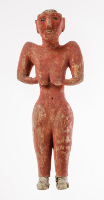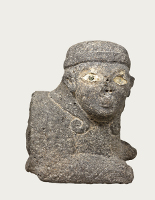The Syrian collection derives largely from Oriental Institute excavations in the Amuq - an area once located in Syria but now a part of Turkey. Acquired between 1932 and 1938, these artifacts span the history of northern Syria from earliest times to the Roman period. They are augmented by materials from the Oriental Institute's work at other Syrian sites, including Tell-Fakhariyah near the Khabur River.
Bronze Statuettes
Archaeologists found these three statuettes in a cache that contained three male and three female figurines. They are the earliest known metal castings of human figures in the round from Syria. The males wear broad belts and helmets covered with a silver alloy; they probably once held weapons in their upraised hands. The naked females' hair is held in place with a headband and bound in the back in an elaborate chignon. They cross their arms and grasp their breasts in their hands - a common ancient pose that probably connotes fertility. The statuettes were intended to be mounted in some fashion, for a tang projects below the feet of each one.
The skill with which these unique pieces were modelled and the technical knowledge that was needed for their casting reveal surprisingly high standards of artistic and technical achievement in Syria at the beginning of the third millennium B.C.
Krater of Khirbet Kerak Ware
This jar is made of a specific ware named after the Palestinian site of Khirbet Kerak, where it was first discovered. Vessels of Khirbet Kerak ware were made by hand and covered both inside and out with a brilliantly polished slip, originally orange-red in color (as on the interior of this vessel) but turned to black on the exterior by specialized treatment during firing. This large pot bears a typical decoration of horizontal and vertical flutings separated by zigzags, perhaps in imitation of fluted metal prototypes.
Male and Female Figures
A naked female and a partially clothed male are represented by this unique pair of red-coated stone figurines. Hair or headdresses made of a separate material were probably once attached to the pegs atop their heads. The male, who stands with his hands at his sides, wears a loincloth tied at the back. The female grasps her breasts with her hands-a common ancient pose that probably connotes fertility. She appears to be naked except for some type of foot-gear applied to her stump-like feet.
Female Sphinx
Sphinxes-imaginary creatures composed of a lion's body and a human head-are a motif that originated in Egypt and became common in the art of Western Asia beginning in the latter part of the second millennium B.C. This recumbent sphinx of local Syrian manufacture has an unusually vivacious character due to the position of the head, which is turned sideways with the chin slightly raised, not at the stiff right angle often found in ancient Near Eastern sculpture. Its hair is secured with a headband knotted at the back of the head and falls in two large curls onto its breast. The dowel hole in the base of the body indicates that it was part of some large object-possibly an arm of a stone throne.
Victorious Assyrian Soldiers
After they had conquered Tell Ta'yinat, the Assyrians carved these reliefs and used them to decorate a palace or public structure. The scene shows victorious Assyrian soldiers carrying the cut-off heads of their defeated enemies to a location where the number of those slain would be counted. Beneath the soldiers' feet lie the decapitated bodies. Each soldier wears a helmet, carries a bow and quiver over his shoulder, and holds three arrows in his right hand. At a later date, perhaps after the decline of Assyrian power, the reliefs were reused, face-down, as paving stones.
Cypriot Juglet
Vessels such as this one were imported into Syria from Cyprus in ancient times, during a period of strong commercial contacts between that island and the Levant. This juglet belongs to a type of pottery known as bichrome ware because of its painted decoration in black and red. It is the work of a talented potter who used geometric ornament-such as the concentric circles on the globular body-not only to harmonize with, but even to enhance, the shape of the vessel.







